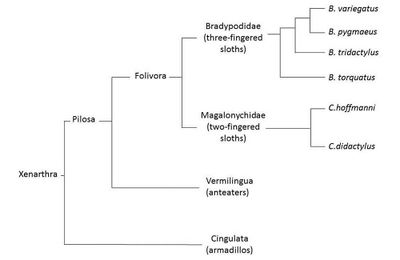Sloth evolution
Introduction
Despite their similar appearances, the rise of modern sloths is an interesting story of convergent evolution. There are two families of sloths, the two-toed sloth and the three-toed sloth, but there are six different species total. Two-toed sloths belong to the genus Choloepus and three-toed sloths belong to the genus Bradypus. Known for their slow movements and inefficient digestive systems, these creatures populate South American and Central American rainforests. Their diets mainly consist of leaves and fruits. All species of sloths spend their time in the rainforest canopy, spending between 15-20 hours a day sleeping, and only venturing to the floor in order to defecate[1]. The forest floor is full of predators that sloths mainly avoid by hiding in the forest canopy. Their slow movements are due to their extremely slow metabolism, as they attempt to conserve energy by controlling movement speed. Sloths are solitary in nature, and spend most of their lives alone. The mating habits of sloths are unique, as they spend majority of their time in the trees, meaning they mate and give birth in the trees Cite error: Closing </ref> missing for <ref> tag, it was discovered that the Bradypus and Choloepus species evolved through convergent evolution, which is where organisms with different ancestors or from different periods evolved similar phenotypical traits. The hands and claws of the sloth have changed over time to resemble hooks that are used in order to hang from trees with limited effort. The ligaments and muscles of the sloth are not strained when hanging from the trees, another important evolutionary adaptation of the sloth

Links for citations:
https://link.springer.com/article/10.1007/s10914-011-9174-x
https://www.nature.com/articles/s41559-019-0909-z
Microbiome
Include some current research, with a second image.
Conclusion
Overall text length should be at least 1,000 words (before counting references), with at least 2 images. Include at least 5 references under Reference section.
References
Edited by Cassandra Lis, student of Joan Slonczewski for BIOL 116 Information in Living Systems, 2019, Kenyon College.
